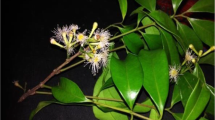Abstract
Gymnema sylvestre is commonly used in indigenous system of medicine to control diabetes mellitus and is a source of various chemical constituents which are medicinally important. There is much scope to study pharmacognosy of this potent antidiabetic plant. Pharmacognostic study of leaf, stem and roots was performed. For quantitative microscopy of leaf the authors observed stomatal index 12 per mm2 area. The studied plant material showed the presence of saponin, proteins, sugars, alkaloids while starch is absent in leaf, stem and root. Phytochemical analysis of plant material showed saponins, proteins, reducing sugars and fats present in all samples. For percent extractive values methanolic extract showed highest extractive value in leaf (6.25), stem (4.9) and root (1.75) while benzene showed lowest extractive values in leaf (1.2), stem (0.5) and root (0.5). The distilled water, acetone, absolute alcohol, petroleum ether and chloroform showed moderate percentage extractive value. The total ash content of leaf (0.083) was higher than that of stem (0.047) and root (0.036), and acid insoluble ash of stem (0.02) was higher than that of leaf (0.01) and root (0.001). The authors observed quantity of gymnemic acid for leaf, stem and root as 33.52, 22.20 and 13.00 mg/g DW respectively by high performance thin layer chromatography.







Similar content being viewed by others
References
Rapini A, Chase MW, Goyder DJ, Griffiths J (2003) Asclepiadaceae classification: evaluating the phylogenetic relationships of New World Asclepiadaceae (Apocynaceae). Taxon 52:33–50
Anonymous (2001) Use of marker compounds in manufacturing and labelling botanically derive dietary supplements. American Herbal Products Associations, Silver Spring
Mall GK, Mishra PK, Prakash V (2009) Antidiabetic and hypolipidemic activity of Gymnema sylvestre in alloxan induced diabetic rats. GJBBR 4(1):37–42
Manohar SH, Naik PM, Praveen N, Murthy HN (2009) Distribution of gymnemic acid in various organs of Gymnema sylvestre. J For Res 20(3):268–270
Trivedi PD, Pundarikakshudu K (2008) A validated high performance thin-layer chromatographic method for the estimation of gymnemic acids through gymnemagenin in Gymnema sylvestre, materials, extracts and formulations. Int J Appl Sci 6:1–19
Spasov A, Samokhina MP, Bulanov AE (2008) Antidiabetic properties of Gymnema sylvestre. Pharm Chem J 42(11):626–629
Madhurima, Ansari SH, Prawez A, Sayeed A, Akhtar MS (2009) Parmacognostic and phytochemical analysis of Gymnema sylvestre R. Br. leaves. J Herb Med Toxicol 3(1):73–80
Yoshikawa K, Ahihira S, Matsura K, Miyase T (1992) Dammarane saponin from Gymnema sylvestre. Phytochemistry 31:237–241
Satdive RK, Abhilash P, Fulzele DP (2003) Antimicrobial activity of Gymnema sylvestre leaf extract. Fitoterapia 74(7–8):699–701
Shivanna Y, Raveesha KA (2009) In vitro antibacterial effect of selected medicinal plant extracts. J Nat Prod 2:64–69
Khanna VG, Kannabiran K (2008) Antimicrobial activity of saponin fractions of the leaves of Gymnema sylvestre and Eclipta prostrate. World J Microbiol Biotechnol 24:2737–2740
Malik JK, Manvi FV, Alagawadi KR, Noolvi M (2008) Evalution of antiinflammatory activity of Gymnema sylvestre leaves extract in rats. Int J Green Pharm 2:114–115
Shaw JE, Sicree RA, Zimmet PZ (2010) Global estimates of the prevalence of diabetes for 2010 and 2030. Diabetes Res Clin Pract 87:4–14
Johanson DA (1940) Plant microtechnique. McGraw-Hill Book co. Inc., New York
Wallis TE (1967) A textbook of pharmacognosy. J and A Churchill Ltd, London
Trease G, Evans W (1972) Pharmacognosy. University press Aberdeen, Great Britain, pp 161–163
Krishnamurthy KV (1988) Methods in plant histochemistry. Vishvanandan Pvt. Ltd, Madras
Harborne JB (1973) Phytochemical methods, 2nd edn. Chapman and Hall International edition, London, pp 5–8
Trease GE, Evans WC (eds) (2002) Trease and Evans pharmacognosy, 15th edn. W. B. Saunders, Edinburgh/London/New York/Philadelphia/St. Louis/Sydney/Toranto, pp 3–4, 528–533, 538–547
Anonymous (1955) Pharmacopoeia of India, 1st edn. Government of India, Ministry of Health Manager Publication, Delhi, pp 370–864
Chase C, Pratt R (1949) Fluorescence of powdered vegetable drugs with particular reference to development of system of identification. J Am Pharm Assoc 38:324
Saneja A, Sharma C, Aneja KR, Pahwa R (2010) Gymnema sylvestre (Gurmar): a review. Der Pharm Lett 2(1):275–284
Najafi S, Deokule SS (2011) Studies on Gymnema sylvestre—a medicinally important plant of the family Asclepiadaceae. TJS 9(2):26–32
Kalidass C, Mohan VR (2010) Pharmacognostical and phytochemical investigation studies on Gymnema sylvestre R.Br. Int J Biol Technol 1(1):8–11
Author information
Authors and Affiliations
Corresponding author
Rights and permissions
About this article
Cite this article
Nikalje, G.C., Zimare, S.B. & Malpathak, N.P. A Comparative Pharmacognostic Study on the Leaf, Stem and Root Components of Gymnema sylvestre (Retz) R. Br. ex. Sm. Proc. Natl. Acad. Sci., India, Sect. B Biol. Sci. 83, 125–134 (2013). https://doi.org/10.1007/s40011-012-0088-z
Received:
Revised:
Accepted:
Published:
Issue Date:
DOI: https://doi.org/10.1007/s40011-012-0088-z




